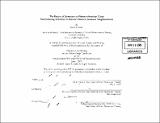The return of streetcars to western American cities : reintroducing streetcars in Denver's historic streetcar neighborhoods
Author(s)
Snider, Sarah E. (Sarah Elizabeth)
DownloadFull printable version (39.03Mb)
Alternative title
Reintroducing streetcars in Denver's historic streetcar neighborhoods
Other Contributors
Massachusetts Institute of Technology. Urban Design Program.
Advisor
Sam Bass Warner.
Terms of use
Metadata
Show full item recordAbstract
Modern streetcars are making a comeback in the United States after their disappearance in the mid twentieth century. They resemble their distant relative, also known as the trolley, in many ways but express a contemporary, provide modern conveniences, and act as a magnet for redevelopment within the city. Modern streetcars build on the theory behind the European tram systems and provide desirable transportation options to support a range of densities in urban living. Currently in the United States, Portland, OR and Seattle,WA operate one modern streetcar line and have plans to expand their singular line into a network. Using these two routes, the plans for system expansion, and the individual cities that support them as case studies, this thesis analyzes the potential for streetcars to return to Denver, CO.The analysis for the Mile High City was conducted using my knowledge of and research on Denver and the surrounding metropolitan region, its historical skeleton that developed around the streetcar, and the City's current trends in public transportation and planning processes. Based on a multifaceted analysis that includes studying the relationship of potential streetcar route length, multi-modal connections, major destinations, high bus ridership routes, projected residential density, projected employment density, and redevelopment potential based on use and zoning, Denver is in fact an appropriate city for the return of streetcars. (cont.) Not only would one streetcar be successful, but an integrated system could serve the City and its surrounding urban neighborhoods well. Taking the analysis one step further, the research attempts to compare a potential modern streetcar system for Denver with the historic streetcar routes that operated until 1949. Many observations arise, including the obvious difference in the limited number of modern lines versus the vast number of historic routes. Modern streetcars typically occur on primarily mixed-use corridors rather than pass through strictly residential neighborhoods as they once did. It is also evident that modern streetcars in Denver would direct redevelopment within the city whereas historic streetcars directed development to the edge of the city.This ability to direct development and redevelopment within the city's boundaries in addition to providing transportation fit in line with Denver's goals for growth management, multi-modal transportation options, and neighborhood revitalization.
Description
Thesis (M.C.P.)--Massachusetts Institute of Technology, Dept. of Urban Studies and Planning, 2009. Author also earned an Urban Design Certificate from the Program in Urban Design; a joint graduate program with the Dept. of Architecture and the Dept. of Urban Studies and Planning. Includes bibliographical references.
Date issued
2009Department
Massachusetts Institute of Technology. Urban Design Program; Massachusetts Institute of Technology. Department of Urban Studies and PlanningPublisher
Massachusetts Institute of Technology
Keywords
Urban Studies and Planning., Urban Design Program.